How to Get a Partnership Ad Code on Instagram (Brands & Creators)
If you’re doing UGC ads on Instagram, you need Partnership Ad codes! Here’s our breakdown of where to find Instagram Ad codes and how to generate...
UGC ads are a top priority for brands looking to boost paid performance and give their marketing a human touch. Learn how to use UGC in ads with examples.


Skip to Section 👇Why Brands Need User-Generated Content for Ads 3 Best Practices for Running UGC Ads |
UGC ads are paid social media ads featuring content originally published by creators, not brands.
Popular formats for UGC ads include videos, photos and reviews on TikTok or Instagram These ads can be repurposed from organic posts or sponsored content from influencers and UGC creators.
The difference between user-generated content and UGC ads is that the latter has an ad budget behind it. While "true" UGC is organic content from customers, UGC ads are typically created on behalf of brands by creators as part of a gifted or paid collaboration.
If you want to spot a UGC ad in the wild, look for the "Sponsored" label on TikTok or the "Paid partnership" label on Instagram.

Done right, UGC ads don't feel like ads at all. That's part of why they're so powerful for brands.
UGC ads dominate TikTok, Instagram and social media platforms at large. Below are three types of user-generated content ads with examples to highlight how they work.
TikTok's native UGC ads are called Spark Ads.
The idea of a Spark Ad is simple: take an existing video from a creator and transform it into an ad.
While Spark Ads can technically be run from a brand's account, they perform best when piggybacking on a creator's high audience engagement and reach.

Below is an example of a TikTok UGC created for Kiala Nutrition. The brand netted a staggering 75+ million impressions and 10,000+ conversions from its Spark campaign. Note how the creator speaks candidly to her audience and how the product she's promoting is a great fit for her audience.
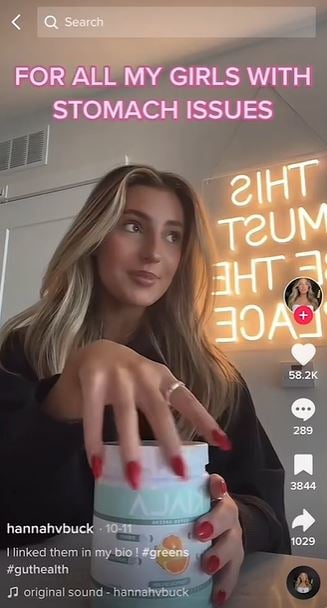
Source: TikTok
It’s no surprise that Spark campaigns are among the most popular types of TikTok ads. The platform cites higher views, engagement rates and conversions for Spark Ads over other types. Based on our own internal data, two-thirds of brands plan on Sparking their influencer content as ads this year.
TikTok's ongoing advice to "Make TikToks, not ads" isn't just marketing fluff, either. We've seen firsthand how Spark Ads perform best when they're raw and unpolished TikTok UGC.
Note: Instagram's UGC ads were formerly called "Branded Content Ads" but this has changed!
Instagram rolled out its own suite of native creator ad tools after UGC ads took off on TikTok.
And much like Spark Ads, Instagram Partnership ads transform UGC into paid promotions. Creators receive attribution for their content with a “Paid partnership” or “Sponsored” label.

UGC ads on Instagram also tend to be more "produced" than TikTok Spark ads. Sure, authenticity matters on both platforms. This includes captions, detailed tutorials and narrations.
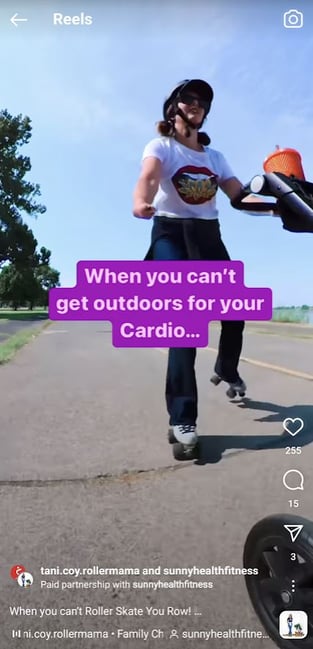
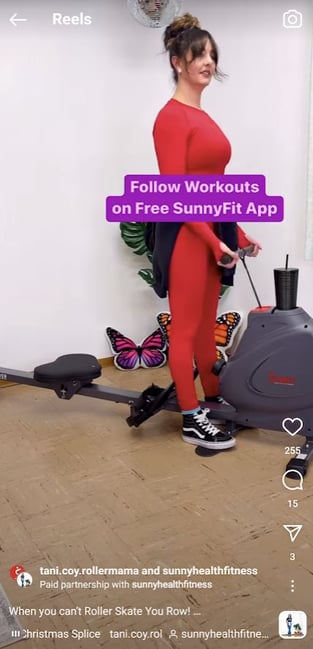
Source: @tani.coy.rollermama
That said, Instagram ads usually feature more edits and creative touches. This also explains why top-performing influencer Reels are longer than TikTok videos based on our analysis of 2,000+ videos.
This is where the world of UGC ads can get super confusing but stick with us!
UGC-style ads are paid social media posts that resemble organic influencer content. Unlike Spark Ads or Partnership Ads, these ads are run through a brand's @handle (and not the account of the creator who produced them).
These posts look like typical UGC ads at a glance. That's the point!
Check out the two UGC ad examples below to see the distinction.
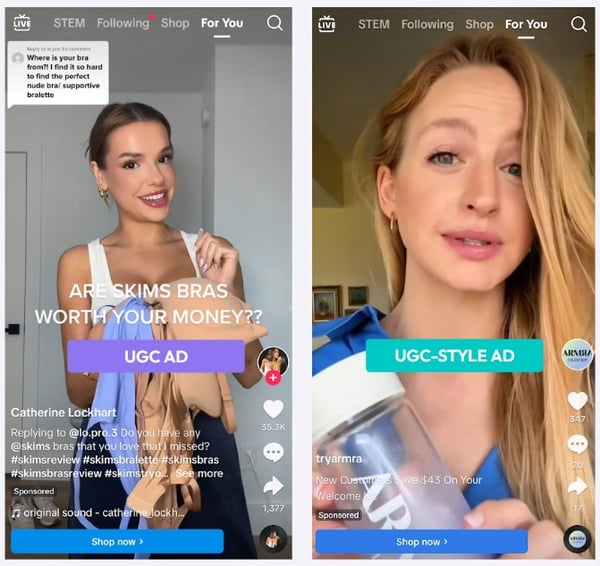
Note the subtle difference in presentation between the Spark Ad on the left and the UGC-style ad on the right. Likewise, notice the difference in engagement rates between them.
Producing UGC-style ads is in contrast with the streamlined process of running ads on TikTok or IG with each app's native UGC ad tools. Brands primarily run UGC-style ads to control and edit the messaging of their promotions.
However, there are some potential downsides of UGC-style ads versus "true" UGC ads. For starters, UGC-style ads require negotiations with creators and careful creative briefing.
Putting together ad briefs and tweaking ad creatives and targeting is also much more time-consuming than simply whitelisting UGC. Your ad targeting and potential to get in front of a creator's authentic audience are limited when you run ads solely through your @handle.
While brands can literally "create" user-generated content or UGC ads by definition, they can encourage and source it.
The steps involved in creating UGC are similar between TikTok and Instagram.
To kick things off, creators post content on behalf of a brand. This might be a shout-out post on Instagram or a review video on TikTok.
Then, the brand requests permission to promote the post in a UGC ad. This can be done in a few different ways:
After content usage rights are secured, brands can boost the organic post as an ad via whitelisting (aka allowlisting). This process uses branded content tools (Spark Ads and Partnership Ads) to speed up the process and run ads through a creator's @handle.

Alternatively, brands can hire creators or use internal team members to create UGC-style ads. Ads produced by UGC creators for brands that are never posted organically are sometimes referred to as "dark posts."
All of this can be pretty confusing. We totally get it!

No matter what you call it, the concept is the same: turning creator content into ads.
Despite all the confusion, the process of creating UGC ads is actually easier than it's ever been on both TikTok and IG. For example, creators can exchange their Spark Ad codes with brands immediately to turn an organic post into an ad ASAP. Same with Partnership Ad codes.
UGC ads are everywhere for a reason.
Because your satisfied customers are your best billboards.
These types of ads make perfect sense for brands already collaborating with influencers and sourcing content customer content.
Here’s a quick breakdown of why brands are shifting to UGC from brand-generated ads:
UGC’s ability to increase conversions across the funnel is well-documented.
Recent research says that shoppers who interact with UGC drive a 100.6 % lift in conversions.
Meanwhile, repurposing UGC for ads is the fastest-growing goal among brands using our platform.
Consumers crave authentic content and you can't get much more authentic than real creators that resemble your actual customers.
For brands running ongoing promotions and launches, user-generated content offers a way for brands to run always-on ads without running out of creatives. Food for thought: more ad assets from creators and customers mean less work for your team.
That's why repurposing your UGC into ads translates to serious time and resources saved.
Simple as! Creative UGC is a welcome break from lifeless product photos.
Check out this TikTok from Hoover featuring a UGC creator earning 41+ million views. From product reviews to unboxings and beyond, there are so many UGC ad formats primed to engage potential customers that don't feel super "salesy."
This video was my “ah ha!” moment for short form and Tik Tok.
— Colin Landforce 🛠,🛠 (@landforce) January 7, 2023
Few products less “viral” than a mf vacuum cleaner.
41M organic views.
I bet this drove 7 figures in revenue with effectively zero budget. pic.twitter.com/SGQMWErGCW
All of the above illustrates why brands are investing in a dedicated UGC marketing strategy. Every piece of creator content you source serves as valuable social proof and potentially powerful ads.
Brands are spoiled for choice when it comes to where and how to integrate user-generated content in promotions.
To wrap things up, here are some quick best practices and considerations for using UGC in ads.
While brands have plenty of options for UGC ad creatives, consider how short-form video has taken over social media at large.
And it’s well-documented that marketers are going all-in on formats such as TikTok and Reels.
Here’s a snapshot of the benefits of short-form UGC videos as an ad format:
Our recent influencer benchmark report also notes that TikTok videos are currently the most requested type of content from brands working with influencers. This makes short-form video a solid starting point for a UGC ad campaign.
As noted in our UGC advertising panel, experts recommend testing dozens of ad creatives at any given time to fine-tune their engagement campaigns.
Making the most of formats like Spark Ads or Partnership Ads requires rapid testing of creatives and messaging. This includes:
Only having a handful of UGC posts to promote doesn’t give you many options or opportunities to optimize your future campaigns. The more creators you work with, the more potential ad creatives you have to repurpose and promote. All the more reason to build campaigns around micro-influencers and smaller UGC creators which are easier to scale.
However, brands need to consider quality and quantity when it comes to UGC creators.
The effectiveness of creator-based ads boils down to how much your creators resemble your target audience. Anything you run as an ad should represent your brand’s best posts, too.
Finding the right creators for your UGC ads is a time-sink if you're monitoring your @mentions and uses of your brand’s hashtag by hand. That's why brands are turning to UGC platforms like Statusphere to match with creators versus having to conduct outreach and vet them individually.
For example, being able to target UGC creators for ads based on factors like demographics, shopping preferences and personal interests will yield much more authentic content than generic search filters or random outreach.
Brands see higher paid performance while doing less legwork with raw and unpolished UGC ads.
As a result, authentic creator content is in high demand.
And if you need to streamline the process of earning more UGC to run as ads, our platform can help.
Statusphere's influencer marketing software helps brands get guaranteed, rights-ready content to promote via social media. Our advanced matchmaking algorithm, vetted creator network and fulfillment technology speed up the process of sourcing authentic UGC for your brand at scale.
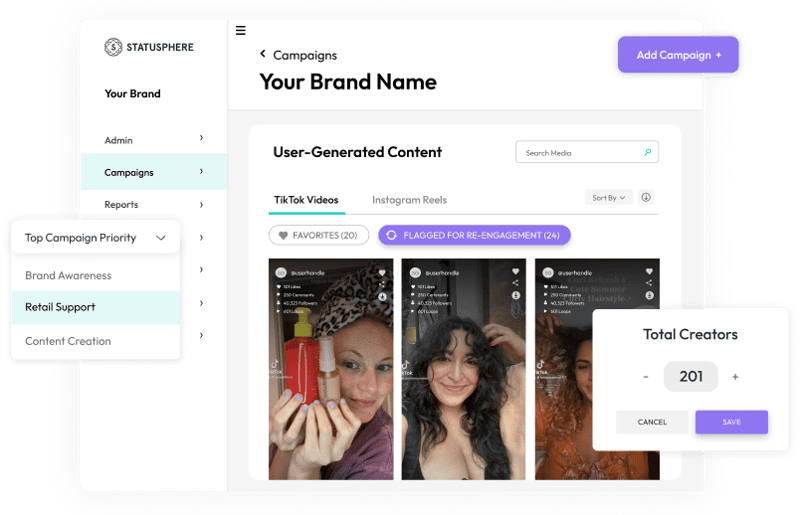
With Statusphere, brands can get instant Spark Ad codes and Partnership Ad codes without having to wait for usage rights or negotiate rates. Our platform has generated 75,000+ pieces of UGC for brands, saving them 11,000+ hours.
Want a peek at how our platform works? Get in touch with one of our experts to see how we can our software can get your brand rights-ready UGC at scale.
This article was first published in February 2023. It was last updated October 9, 2024.

Most brands have multiple channels and strategies for getting UGC, which include:
UGC-style ads are posts made on behalf of brands that resemble authentic customer content but are actually posted by paid creators and influencers. With UGC-style ads, brands have more control over their ad creatives and messaging. However, too much creative control from brands can result in rigid ads that don't feel "real."
UGC ads are typically presented from a creator's @handle rather than a brand's. These types of ads also allow brands to tap into a creator's audience and reach to boost the engagement of their campaigns.
By comparison, traditional social media ads involve brands making ad creatives themselves. This can be done in-house or outsourced to an agency.
According to Statusphere's analysis of over 34,000 creator posts, TikTok videos are the most requested type of content among brands working with influencers (and Instagram Reels are the second-most requested). Brands that run UGC ads frequently use short-form videos as the basis for their campaigns.
That said, UGC ads aren't exclusively videos. Many brands run slideshow-style UGC ads with Carousels on Instagram.
The best UGC ads closely resemble organic content in terms of editing, presentation and tone. For example, most TikTok UGC ads are raw and unpolished. The human element of a UGC ad is what makes it engaging compared to more "produced" branded content.
If you’re doing UGC ads on Instagram, you need Partnership Ad codes! Here’s our breakdown of where to find Instagram Ad codes and how to generate...
TikTok Spark Ads turn your brand's UGC into high-performing paid promotions. We explain how to set up Spark Ads and ways to optimize your TikTok...
Partnership Ads on Instagram let brands promote UGC to a wider audience. Learn how Instagram Partnership Ads work, why they’re effective and how to...
Be the first to know about the latest tools, trends and strategies in influencer marketing for brands.